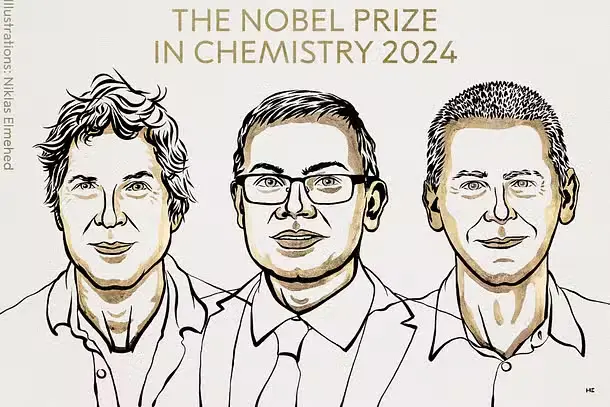Why AI and Protein Structures Matter in Modern Science
The announcement of the 2024 Nobel Prize in Chemistry brings groundbreaking advancements in AI and Protein Structures to the forefront of scientific achievement. This year’s laureates, David Baker, Demis Hassabis, and John Jumper, have made significant strides by integrating artificial intelligence with biology, tackling one of science’s most complex challenges: predicting protein structures. Their work not only marks a technical triumph but also promises transformative impacts on medicine, environmental science, and sustainable development.
The 2024 Nobel Prize in Chemistry has just been awarded, and this year it’s all about protein structure and AI. David Baker, Demis Hassabis, and John Jumper have been honored for their pioneering work, blending biology with AI to tackle one of science’s most challenging puzzles: predicting protein structures. This isn’t just a technical achievement—it’s a breakthrough with far-reaching implications for medicine, environmental science, and even sustainable development.
Protein Pioneers: Who Are They?
David Baker, known for his work in synthetic proteins, has created custom molecules that are set to transform everything from vaccines to nanotechnology. Imagine proteins engineered to target specific diseases or even clean up pollutants. His research is setting the stage for innovations that could redefine healthcare and environmental protection.
On the AI front, Demis Hassabis and John Jumper have developed AlphaFold, a model that can predict protein structures with unprecedented accuracy through AI. Since its debut, AlphaFold has successfully predicted over 200 million protein structures. Before this, scientists would spend years trying to understand just one protein. Now, with AlphaFold, they’re gaining insights that could speed up the fight against antibiotic resistance, develop targeted cancer therapies, and explore other life-altering applications.
Why Proteins Matter (And Why AI is Key)
Proteins are nature’s building blocks. They’re involved in nearly every function within our bodies and countless processes in the natural world. However, the way a protein folds determines its function, and misfolded proteins can lead to diseases. So, understanding these structures is crucial—and notoriously difficult.
Enter AI. AlphaFold has changed the game by rapidly predicting protein structures with high accuracy. What’s mind-blowing is that this was once considered an unsolvable problem. This is a fantastic reminder of AI’s potential—not just in tech but in life sciences as well. It’s clear now that AI is more than a tool for digital convenience; it’s a catalyst for unlocking the mysteries of life.
The Bigger Picture: A Blueprint for Progress
This Nobel Prize underscores the growing synergy between AI and biology, highlighting a future where technology could help solve some of humanity’s biggest challenges. Whether it’s discovering new drugs or developing solutions for environmental crises, the applications are limitless. The work of Baker, Hassabis, and Jumper exemplifies how innovation thrives at the intersection of fields and offers a glimpse into a world where AI doesn’t just change our devices but transforms our understanding of life.
As we stand on the cusp of this new frontier, it’s exciting to think about where these discoveries will lead us next. The question isn’t just about what we can do now, but what we will be able to achieve tomorrow, thanks to the blend of AI and science.
AstraZeneca AI Partnership: 4 Ways AI is Transforming Cancer Drug Trial
AI News 2024: Breakthroughs in Supercomputers, Healthcare, and Deepfake Detection
Source: Nobel Prize



